![]()
Computer-to-Minidisc
Note: this page is NOT intended to make everyone who reads it an expert in making perfect recordings. To get it sounding exactly the way you want might take many hours (or years) of practice and experimentation. Rather, this page is intended only for those "newbies" who want to get "up and running" quickly.
There are many different ways of connecting your MD to your computer. Which ones you can try will depend largely on which hardware has been installed on your computer. What follows is a description of four different ways to record audio from your computer to a portable minidisc.
 |
Analog miniplug to analog miniplug: This is recommended for all beginners. It will work with any computer and minidisc recorder. Beginners should try this method FIRST before trying any of the others. Mastering this method first will allow you to have more success learning the other methods. |
 |
Digital TOSLINK to optical miniplug |
 |
USB to analog miniplug |
 |
USB to optical miniplug |
| .Method 1: analog miniplug to analog miniplug... | ||||||||
 |
This is the simplest method of recording
a minidisc from the computer.
First, identify the plugs that you have on your computer and minidisc recorder so that you know what you are working with. The picture at the right shows the side of a minidisc recorder. The plug to the far left (with the white shielding) says "line in (Optical)". This actually means that the same plug is being used for the analog line in AND the digital optical line in. In this case, we are only interested in the analog line-in capability. |
|||||||
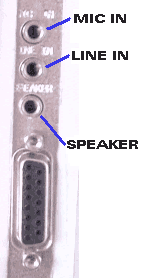 |
Next, check your computer's soundcard. On even the most basic soundcards, there will be a "speaker out". You can see in the soundcard pictured at the left, it is labeled "speaker". Not all soundcards will look exactly like this, but any soundcard should have a "speaker out" jack. For a brief look at some of the variations in soundcards that exist, go to the page on soundcards. Some soundcards may also have an additional "line out", and this would be even better to use to record from than the speaker output if you do have it. However, the speaker output will work just fine in most cases. | |||||||
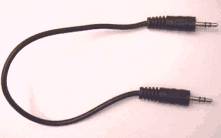 |
You will need a 1/8" miniplug-to-miniplug
cable. If you need to buy one, be very careful to buy a stereo one
and not a mono one. I have had countless people email me desperate
for advice because their recordings were not being made properly, and the
cause was that they purchased a mono cable. If you are not sure how to tell
the difference between a stereo cable and a mono cable, check the
page on computer audio cables.
The cable itself can be easily purchased at any electronics store. If you live in North America, simply march down to your local Radio Shack and they will have one. Also, they are the cheapest cable you will probably ever buy, probably only costing a few dollars. Again, be sure you know that you are buying a stereo one because sometimes the salespeople don't know. |
|||||||
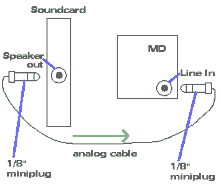 |
Next, you will need to make your
connections. At the left is an oversimplified diagram of the
connection needed. Unplug your computer speakers from the speaker
out plug of your soundcard. Plug one end of the 1/8" miniplug
into the speaker out jack, and plug the other end into the
"line in" jack on the minidisc recorder. You are now set
to record!
Before recording, it is a good idea to shut down any Windows programs that make sounds, because ALL sounds on your computer will be recorded to the minidisc. This includes such programs as ICQ, which can pop-up with a loud noise when you least expect it. |
|||||||
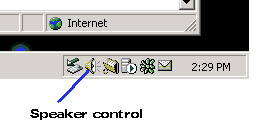
|
The next thing you will do is adjust your
speaker volume. Since this page assumes that the user has a certain
level of knowledge about computer audio such as MP3, it is not
necessary to go into much detail about this issue here. However,
adjusting the volume that goes "out" of your computer and
into the minidisc can be done by first double-clicking on the
speaker icon in the Windows system tray at the bottom right-hand
corner of the screen, as shown to the left. This will open the
computer's "volume control" panel.
The "volume control" on your computer may not necessarily look exactly like the one shown here. The panel itself will vary according to the computer and soundcard setup. Some machines will have more controls here, while others will have less. There may even be "advanced" options available for some controls. However, all computers will include a "volume control" setting which controls the speaker volume. This will most likely be the control to the farthest left on the screen, as shown. When you have located the volume control, ensure that the volume setting is set to somewhere between 50% and 75% of the total. This is most appropriate for minidisc recording. Later you can experiment with louder or softer volume settings. If the setting is too high it will cause distortion and if the setting is too low then the sound will be weak; however somewhere in the 50-75% range is appropriate most of the time. |
|||||||
|
Now...record! |
Press "record" on the minidisc recorder and "play" on the computer's source (if you are recording from a playlist on Winamp, click "play" in Winamp). You will need to wait for all tracks to be recorded to the minidisc in real time. That's it...you should now have a minidisc with the audio from your computer on it. | |||||||
| A note: You will find
that with analog recording, the minidisc recorder will automatically add a
track mark for every 2-second silence it detects during the recording
process. This is because the minidisc recorder interprets this 2 seconds
(or more) of silence as the "gap" between songs. However,
sometimes your songs are too close together, so that they have less than 2
seconds between them, or, as can be the case in classical music
especially, the silence may actually be part of the song. This can present
some problems.
If track marks were added that shouldn't be, you will have to edit them out later. You can do this by "joining" 2 tracks on the minidisc. Refer to the manual for your minidisc recorder on joining tracks. To make the MD recorder add track marks, it may be necessary to add a 2-3 second gap of silence between each song on your playlist. You can do this by creating a 2-3 second track of silence yourself. You can also do this by getting a Winamp plugin that will add this gap. To look at some known plugins, check out the links below:
|
||||||||
| . | ||||||||
| .Method 2: Digital TOSLINK-to-Optical Miniplug | ||||||||
| NOTE: Do not assume that digital recording will necessarily sound better than analog recording. Analog recording, when done properly, can sound indistinguishable from digital recording to human ears. MP3's in particular will most likely not sound ay better when copied through a digital or analog connections, provided the file was recorded properly. For more information about digital versus analog recording, see the section on analog vs. digital. | ||||||||
 |
Recording via an optical miniplug is the
"original" method of digital recording to a minidisc.
The picture at the right shows the side of a minidisc recorder. Check to find the optical input. In this case, the optical input is the center jack in the picture, labelled "Optical/Line In". This is because the minidisc recorder uses the same plug for the analog line in AND the digital optical line in. Since we are recording digitally, we are only interested in the digital optical line-in capability. |
|||||||
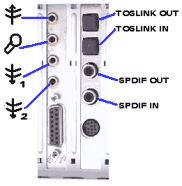 |
Next, check your computer's soundcard. In order to record digitally directly from your soundcard to the minidisc recorder, you must have an optical out on your computer. Not all soundcards have an optical out, so be sure to check your soundcard before proceeding. If you are unsure whether your soundcard has an optical out, you can check it by referring to the page on soundcards. In the soundcard pictured to the left, the optical out is labeled "TOSLINK Out". Not all soundcards will have the same term for any one connector. Some cards may label it "Optical out", others may label it "TOSLINK Out", etc. | |||||||
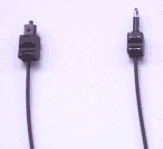 |
You will also need a TOSLINK-to-optical
miniplug cable. This is not as easy to find as an analog cable. In
fact, from what I understand it is actually quite difficult to find
one of these cables in North America.
This cable is very easy to identify. One end will have a TOSLINK plug on it, and the other end will have a miniplug on it. Like all TOSLINK cables, it will glow bright red at the tip of the cable when plugged into a TOSLINK out jack that is powered up. The cable can be purchased at high-end electronics stores, and possibly from Radio Shack in North America, but I am not sure about this. If you are unsure about what cable you need, see the page on computer audio cables. |
|||||||
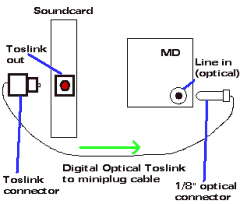 |
Next, you will need to make your
connections. At the left is an oversimplified diagram of the
connection needed. Remove the plastic cap from the TOSLINK out and
plug the TOSLINK end of your cable into the TOSLINK out (make sure
you plug it into the TOSLINK out and not the TOSLINK in).
Plug the miniplug end into the "line in (optical)" jack on
the minidisc recorder.
As with analog recording, before you begin to record, shut down any Windows programs that make sounds, because ALL sounds on your computer will be recorded to the minidisc. This includes such programs as ICQ, which can pop-up with a loud noise when you least expect it. |
|||||||

|
Now adjust your speaker volume. Since
this page assumes that the user has a certain level of knowledge
about computer audio such as MP3, it is not necessary to go into
much detail about this issue here. However, adjusting the volume
that goes "out" of your computer and into the minidisc can
be done by first double-clicking on the speaker icon in the Windows
system tray at the bottom right-hand corner of the screen, as shown
to the left. This will open the computer's "volume
control" panel.
The "volume control" on your computer may not necessarily look exactly like the one shown here. The panel itself will vary according to the computer and soundcard setup. Some machines will have more controls here, while others will have less. There may even be "advanced" options available for some controls. However, all computers will include a "volume control" setting which controls the speaker volume. This will most likely be the control to the farthest left on the screen, as shown. When you have located the volume control, ensure that the volume setting is set to somewhere between 50% and 75% of the total. This is most appropriate for minidisc recording. Later you can experiment with louder or softer volume settings. If the setting is too high it will cause distortion and if the setting is too low then the sound will be weak; however somewhere in the 50-75% range is appropriate most of the time. |
|||||||
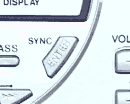 |
Before you begin recording, you may want to set the "Sync record" on your minidisc recorder to the "on" position. This feature will ensure that the minidisc will go immediately into "pause" mode when you press "record" and will not begin recording until you press "play" on the source (in this case your computer). It only works with digital recording, and it does this by detecting that the digital bit stream has started. The advantage is that this can help start recordings more conveniently. The disadvantage is that some minidisc recorders have a tendency to not start fast enough and may "cut off" the first second or so of a track. The only way to know is to try it. | |||||||
| Now...record! | Press "record" on the minidisc recorder and "play" on the computer's source (if you are recording from a playlist on Winamp, click "play" in Winamp). You will need to wait for all tracks to be recorded to the minidisc in real time. | |||||||
| A note: You will find that with digital recording from a computer, the minidisc recorder will not insert track marks between the songs. You must do this yourself after you have finished recording. For some reason computer soundcards do not emit track marks. | ||||||||
| .Method 3: USB to analog | ||||||||
 |
Recently, a method of recording from the
computer's USB port has gained a great deal of attention. In
practice it differs little from the more traditional methods of
recording, but it does offer some advantages. Firstly, the USB cable
used for minidisc recording comes with software that makes recording
quite easy. Second, many low-end soundcards have noise which is
recorded to minidisc, and recording via the USB port can eliminate
this noise. As with other methods of recording, you must be familiar with the input into your minidisc recorder. You must find the analog input. Have a look at your recorder, and consult the manual if you are not sure which one it is. To the left is an MD recorder. The plug in the center, with the white shielding, labeled "(optical) line in" is the plug which is the jack which will be used. The label "(optical) line in" actually means that the same plug is being used for the analog line in AND the digital optical line in. In this case, we are only interested in the analog line-in capability. |
|||||||
 |
Next, make sure that your computer has an available
USB port. Many times the USB ports are not actually labelled "USB";
rather they only have a symbol which looks like the one pictured to the
left. All modern computers are equipped with USB ports; however
there still could be some older machines out there which do not have them.
Many computers have the USB ports located at the back of the machine;
however there are some newer ones that have some USB ports on the front.
Besides checking for the USB port itself, check your operating system. If you are using Windows 98, 2000, or ME, you will have no problems. using the USB port. Windows 95 generally does not have USB support unless you have OSR2, and even then I have been told that it does not work. If you are running Windows 95 and want to use the USB, your only option may be to upgrade your operating system. |
|||||||
| To Windows 95 users: If you are using Windows 95, your USB port won't work unless your release of Windows 95 also includes OSR2 and the USB supplement. The only way to check this is to look at the following: Start-Settings-Control Panel-System-Device Manager, and look for something called a "USB Root Hub". If this hub is present, you should be OK to use your USB ports. If it is not, this means that your release of Windows 95 does not include OSR2, and you will need to upgrade your operating system before you can use your USB port. | ||||||||
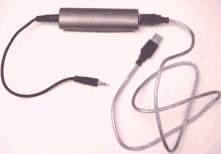 |
Most importantly, you must have the appropriate USB-to-analog
cable before you can proceed. Sony bundles this cable with some of its
minidisc recorders, and there are various places where it can be purchased.
The manufacturer of these cables is The cable installs very easily and Windows will install the necessary drivers. The cable also comes with music software, similar to Winamp. This software allows the user to make playlists and organize the music to be recorded. Although the software itself is not actually needed (you can record any audio that is coming from the computer regardless of the source), it does make the recording process simpler. |
|||||||
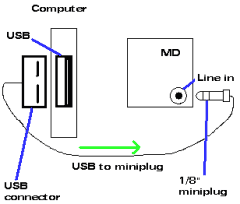 |
Next, you will need to make the right connections. At the left is an oversimplified diagram of the
connection needed. Simply plug the USB end of the cable into the
computer's USB port, and plug the miniplug end into the minidisc's
"line in (optical)" jack.
Remember that before you begin to record, you should shut down any Windows programs that make sounds, because ALL sounds on your computer will be recorded to the minidisc. This includes such programs as ICQ, which can pop-up with a loud noise when you least expect it. |
|||||||

|
Adjust your speaker volume by first
double-clicking on the speaker icon in the Windows system tray at
the bottom right-hand corner of the screen, as shown to the left.
This will open the computer's "volume control" panel.
When you are using a USB audio cable, the panel that appears when you click "speaker" will be different from the regular one that you see when the USB device is not plugged in. The illustration at the left is an example of a control panel for a USB device, although yours may be different from the one pictured. Note how it says "USB Audio Device" at the bottom of the panel. Locate the volume control and ensure that the volume setting is set to somewhere between 50% and 75% of the total. This is most appropriate for minidisc recording. Later you can experiment with louder or softer volume settings. If the setting is too high it will cause distortion and if the setting is too low then the sound will be weak; however somewhere in the 50-75% range is appropriate most of the time. |
|||||||
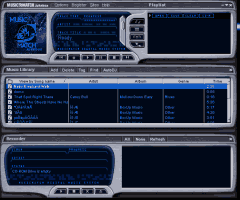 |
If you are using the MusicMatch software that
came bundled with the USB cable, create a playlist of the tracks you
want to record. This software makes the recording process easy. If you are
using Winamp or any other audio software, prapare the appropriate playlist
or other files necessary for the recording.
Note that while you are using the USB method of recording, no sound will come out of your computer's speakers. Your computer will bypass the soundcard altogether and use the USB until the USB is disconnected. |
|||||||
| Record! | Click "Play" on the computer audio software and "Record" on the minidisc. You will be recording in real time and you will have completed your recording. | |||||||
| . | ||||||||
| .Method 4: USB to digital optical | ||||||||
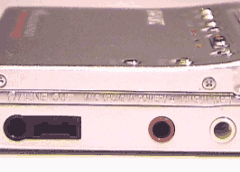
|
USB-to-optical cable/adapters are becoming increasingly popular
with owners of Minidisc recorders. These cable/adapters allow anyone to
record digitally from their computer even if they do not have a digital
soundcard. One popular supplier of these cable/adapters is A word of caution here: It may not be worth your while to try recording digitally from the USB port, for the following reasons:
Again, the description of the jack on the minidisc recorder: The jack on the right-hand side in this illustration says "Line in (Optical)". This means that the same plug is being used for the analog line in AND the digital optical line in and in this case we are interested in the optical-in capability. |
|||||||

|
Of course, you must make sure that your computer has an available
USB port. All modern computers are equipped with USB ports; however
there are still some older machines around which do not have them.
In addition, check your operating system. If you are using Windows
98, 2000, or ME, you will have no problems. If you are using Windows
95, your USB port won't work unless your release of Windows 95 also
includes OSR2. The only way to check this is to look at the
following:
Start-Settings-Control Panel-System-Device Manager, and look for something called a "USB Root Hub". If this hub is present, you should be OK to use your USB ports. If it is not, this means that your release of Windows 95 does not include OSR2, and you will need to upgrade your operating system before you can use your USB port. |
|||||||

|
Most importantly, you must have the appropriate USB-to-optical
cable before you can proceed. Sony bundles this cable with some of its
minidisc recorders, and there are various places where it can be purchased.
The manufacturer of these cables is Xitel, which sells it as the DG-1 The software for this cable must also be installed. It will make this type of recording relatively simple. |
|||||||

|
Next, you will need to make your needed
connections. At the left is an oversimplified diagram of the
connection needed. Simply plug the USB end of the cable into the
computer's USB port, and plug the miniplug end into the minidisc's
"line in (optical)" jack.
Again, the standard reminder that applies whenever recording from your computer: Before you begin to record, you should shut down any Windows programs that make sounds, because ALL sounds on your computer will be recorded to the minidisc during the recording process. Especially troublesome are programs such as ICQ, which have a habit of popping up with a loud noise at the worst possible moment. |
|||||||

|
Adjust your speaker volume by first
double-clicking on the speaker icon in the Windows system tray at
the bottom right-hand corner of the screen, as shown to the left.
This will open the computer's "volume control" panel. The "volume control" on your computer may not necessarily look exactly like the one shown here. The panel itself will be different from the panel that is shown when there is no USB audio device plugged in, but it may also look different than the one shown. However, you will see a "volume control" setting which controls the speaker volume. This will most likely be the control to the farthest left on the screen, as shown. When you have located the volume control, ensure that the volume setting is set to somewhere between 50% and 75% of the total. This is most appropriate for minidisc recording. Later you can experiment with louder or softer volume settings. If the setting is too high it will cause distortion and if the setting is too low then the sound will be weak; however somewhere in the 50-75% range is appropriate most of the time. |
|||||||
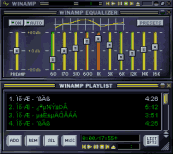
|
If you are using the MusicMatch software that
came bundled with the USB cable, create a playlist of the tracks you
want to record. If you are
using Winamp (pictured on the left) or any other audio software, prepare the appropriate playlist
or other files necessary for the recording.
Note that while you are using the USB method of recording, no sound will come out of your computer's speakers. Your computer will bypass the soundcard altogether and use the USB until the USB is disconnected. |
|||||||
 |
Before you begin recording, you may want to set the "Sync record" on your minidisc recorder to the "on" position. This feature will ensure that the minidisc will go immediately into "pause" mode when you press "record" and will not begin recording until you press "play" on the source (in this case your computer). It only works with digital recording, and it does this by detecting that the digital bit stream has started. The advantage is that this can help start recordings more conveniently. The disadvantage is that some minidisc recorders have a tendency to not start fast enough and may "cut off" the first second or so of a track. The only way to know is to try it. | |||||||
| Next...Record! | Click "Play" on the computer audio software and
"Record" on the minidisc. You will be recording in real time so
you must wait until all the music stops before your recording is finished.
You can monitor the recording by listening to the headphones of your
portable minidisc recorder while it is recording.
When the music is finished, press "Stop" on your portable minidisc. You are now finished recording, and you can listen to your newly recorded minidisc. |
|||||||
 |